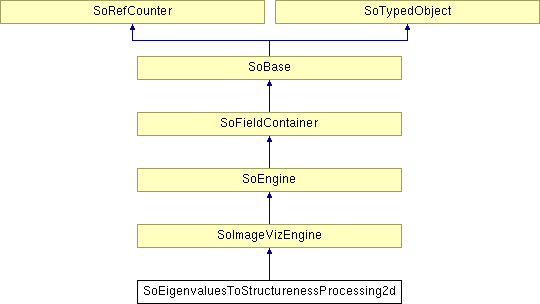SoEigenvaluesToStructurenessProcessing2d Class Reference
[Edge Marking]
 SoEigenvaluesToStructurenessProcessing2d engine computes a structure score image
More...
SoEigenvaluesToStructurenessProcessing2d engine computes a structure score image
More...
#include <ImageViz/Engines/EdgeDetection/EdgeMarking/SoEigenvaluesToStructurenessProcessing2d.h>

Public Types | |
| enum | Lightness { BRIGHT = 0, DARK = 1 } |
| enum | StructureType { ROD = 0, BALL = 1 } |
Public Member Functions | |
| SoEigenvaluesToStructurenessProcessing2d () | |
Public Attributes | |
| SoSFImageDataAdapter | inEigenvaluesImage |
| SoSFEnum | lightness |
| SoSFEnum | structureType |
| SoSFFloat | beta |
| SoSFFloat | noiseCutoff |
| SoImageVizEngineOutput < SoSFImageDataAdapter, SoImageDataAdapter * > | outImage |
Detailed Description
 SoEigenvaluesToStructurenessProcessing2d engine computes a structure score image
SoEigenvaluesToStructurenessProcessing2d engine computes a structure score image
It allows to extract tubular or blob-like structures from dark or bright background.
The computation is based on eigen values  and
and  where
where  .
.
The structure score for bright tubular structures corresponds to :

and the score for bright blob-like structures is computed as follow :

where  is the Hessian norm
is the Hessian norm  ,
,
 is a threshold which controls the blobness sensitivity,
is a threshold which controls the blobness sensitivity,
and c is a sensitivity threshold wich controls the noise influence.
 with
with  the maximum Hessian norm in the image.
the maximum Hessian norm in the image.
For dark objects the conditions on  and
and  are reversed.
are reversed.
The method is referenced by Frangi publication
A.F.Frangi, W.J.Niessen, K.L.Vincken, M.A.Viergever, "Multiscale vessel enhancement filtering"
Lecture Notes in Computer Science(MICCAI), vol. 1496, pp. 130-137, 1998.
This engine provides output float grayscale image where each voxel intensity represents a structure score.
FILE FORMAT/DEFAULT
- EigenvaluesToStructurenessProcessing2d {
| inEigenvaluesImage | NULL |
| lightness | BRIGHT |
| structureType | ROD |
| beta | 0.75f |
| noiseCutoff | 0.5f |
Library references: EigenvaluesToStructureness2d
Member Enumeration Documentation
Constructor & Destructor Documentation
| SoEigenvaluesToStructurenessProcessing2d::SoEigenvaluesToStructurenessProcessing2d | ( | ) |
Constructor.
Member Data Documentation
Blobness sensitivity threshold.
It corresponds to the  term of the score equation. Default value is 0.75f.
term of the score equation. Default value is 0.75f.
Image containing input eigenvalues field.
Type must be float. Spectral series size is 2 (channel 0 = largest Eigen value, channel 1 = smallest Eigen value). Default value is NULL. Supported types include: grayscale color image.
The type of structure lightness to extract.
Use enum Lightness. Default is BRIGHT
Noise scale factor.
It is used for computing the c term of the score equation. Default value is 0.5f.
| SoImageVizEngineOutput<SoSFImageDataAdapter,SoImageDataAdapter*> SoEigenvaluesToStructurenessProcessing2d::outImage |
Output image.
Size (except spectral series, only one), calibration and interpretation of the ouput image are forced to the same values as the input. Type is forced to float. All values are between 0 and 1. Default value is NULL. Supported types include: grayscale binary label color image.
Shape of structures to extract.
Use enum StructureType. Default is ROD
The documentation for this class was generated from the following file:
- ImageViz/Engines/EdgeDetection/EdgeMarking/SoEigenvaluesToStructurenessProcessing2d.h